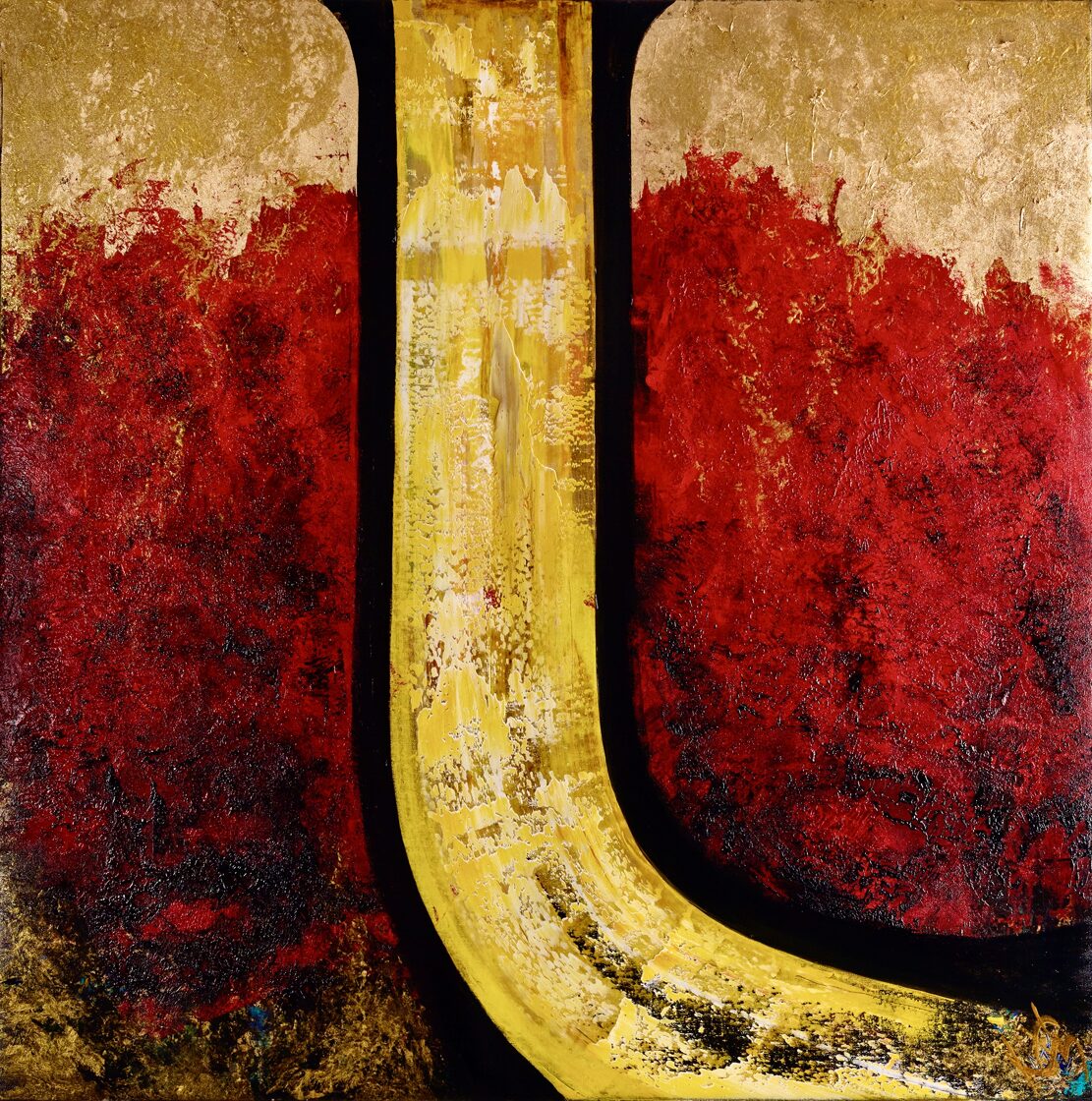PAINTINGS BY TAMÁS NÁRAY AVAILABLE FOR PURCHASE
The colors displayed on the screen may differ from the actual shades of the artworks and prints due to the differing properties/settings of monitors and video cards!
The colors displayed on the screen may differ from the actual shades of the artworks and prints due to the differing properties/settings of monitors and video cards!

The painting titled “Consiliatus Imperius” captures the duality of power and intimacy: the tension when, on the stage of history, human emotions, attachment, and beauty also play a role. It tells the story of Alexander and his companion, Euxenippus, finding each other.
In the upper region, a golden cascade descends in a sharp, strong green stream: at this moment, the lights of the celestial spheres dissolve onto the earth. The greens symbolize youth and fresh strength, which can also be interpreted as a metaphor for the figure of Euxenippus, while the golden gleams carry the promise of being chosen – but their fragmented, unraveling light suggests that something is missing from the full radiance.
In the upper left corner, a burning red block pulses, capturing the gaze as a spot of passion and desire: it contains strength, light, and true charisma – all that the young Euxenippus was measured against.
In the center of the composition, a marble-like, sensually crafted band runs through, bordered above and below with heavy gold inlay, as if framing it: a dividing line between earthly reality and relationships ordained by the heavens. The gold evokes the presence of divine order: reminding us that even the most personal bonds are part of the great fabric of history.
In the title, “conciliatus” evokes the friend, the intimate lover, while “imperius” denotes the imperial perspective. Thus, the work connects two spheres: the public world of power and intimate, fragile human relationships.
The canvas simultaneously recalls the personal stories hidden in the shadow of triumphs and the mystery in which history and emotion are inextricably intertwined.

Some triumphs are not fulfilled in the destruction of the defeated; sometimes, the true glory of victory shines in the recognition of the greatness of the other person.
After the battle fought along the Hydaspes River, Alexander stood above his opponent not only as a general but as a demigod: he did not destroy Porus, the brave and steadfast Indian king, but, preserving his dignity, raised him to his side.
The fiery reds of the canvas evoke the heat of battle, the fierce struggle soaked with blood and sweat. The golden streams emerging from the blazing colors open up another dimension: the flow of divine energies that guided Alexander's decision. Porus appears as a gray, rocky mass: immovable, proud, his strength not collapsing even with defeat.
The square appearing on the right side of the composition, symbolizing altar sanctity, points toward royal dignity and divine order: the seal of the shared historical fate of the victor and the vanquished. The golden band dividing the horizon highlights the relationship between the two rulers: Alexander's gesture, by which he preserved Porus's life and throne, thus granting him a place forever in the pages of history.
While the painting, with dramatic gestures, tells of the victory along the Hydaspes, it also speaks of the two faces of human character: one is the ruthless conqueror, the other is the king capable of respecting greatness. This duality is what elevates Alexander from a famous general to a myth-making force.













This extremely complex work is a dramatic station of the 'Alexander the Great - Imperator Ultimus' cycle: for it not only captures a moment from the life journey of Alexander, but also the ancient archetype of the female fate: the eternal intertwining of love and death, desire and destiny.
At the same time, the work visualizes an emotional triangle, which evokes both a love drama and a sacred iconography: the painter elevates earthly emotions to the level of timeless myth. The triangle does not close, but remains open – indicating that the dynamics of relationships never found peace, and ultimately ended in tragic closure – and with this triangle symbolism, the work not only depicts Roxána, but also unfolds Alexander's emotional universe: the eternal tension between the three peaks of passion, friendship, and power.
In the upper register, the yellowish-gold horizon, then the swirling bright sky above it, suggests a promise, a hope – Roxána's fate at first truly carried the promise of triumph and rise. The Bactrian girl, whose beauty became legendary, captured Alexander's heart: in their marriage, East and West, the Macedonian and Persian worlds united.
Yet the essence of the painting does not lie in the horizon, but in the darkening crevice at the center, which refers to the depths of the female principle. This black space, which the artist boldly evokes as a symbol of femininity, alludes both to the source of life and the vortex of destruction.
A mother, with the possibility of life, also provides the inevitability of death.
In the figure of Roxána, fertility, love, and tragedy are embodied at once. The life-giving mother who brought Alexander IV into the world, and at the same time the woman who was ultimately imprisoned and became a victim of murder – thus herself becoming a kind of sacrificial cave, the scene of life and death. Yet this dark depth carries not only Roxána's sexuality, but also the dark, jealousy-laden side of the relationship. Around it, reddish, crimson tones pulse: the flames of love, signs of Alexander's passion. This red, however, is not uniform: sometimes it flares up, sometimes it fades, showing the pulsation of passion and uncertainty.
Between the reds and blacks, turquoise spots cut through, like celestial lights flashing into a wound: they symbolize both the brief flare of hope and the merciless turns of fate, but are also connected to the spiritual and emotional presence of Hephaestion. The cold lights evoke not only rational thinking and the companionship of a general, but also the timeless purity of the intimate bonds between men.
In Roxána's story, power and love formed a fatal mixture: the initial divine gift ultimately became the prey of political intrigues and the power struggles of men.
The color scheme of the painting – the passion blazing in red, the danger plunging into dark depths, and the gold suggesting the promise of the horizon – sums up an entire life story. Black and red – Roxána: sexuality, passion, jealousy; turquoise – Hephaestion: friendship, spiritual community, purity; and the gold – Alexander: the king, torn apart by the two forces, while his own fate is also driven toward destiny.
Thus, the figure of Roxána is not only a historical figure, but also an archetype: beauty that elevates and leads to ruin; the mother who gives and loses life; the queen who embodies both triumph and destruction.

In the painting titled “The Pilgrimage”, the canvas itself becomes a stage where myth and history converge.
Alexander's journey to the Siwa Oasis is not simply a geographical movement, but a sacred crossing, a passage of a human fate toward divine order. At first glance, the painting's fragmented, restless surfaces speak of this transition: the red tells of the heat of struggle and the body's torment, the yellow of the promise of divine light, while the whitish, rock-like base evokes the timeless face of the eternal, solid desert.
The black, downward-flowing lines bring the experience of the proximity of death, the exhaustion of the body, the uncertainty of existence closer to the viewer. As if the canvas itself were drying out, crumbling, like the lips of a wanderer in the hot sand. And yet: the darkness does not engulf, but leads through – it serves as a gate, behind which shines the golden light of the Sun God, the goal, the promise of initiation.
In the pilgrimage, reality and vision, human weakness and divine support intertwine. There are no sharp boundaries in the painting: the colors blend, flow, and blur into each other. This dissolution is itself the sacred experience, where man loses his earthly coordinates to find his place in the order of the gods.
Thus, “The Pilgrimage” becomes an allegory of perseverance and inner strength: for Alexander – and every viewer – the message of the journey is that the greatest victory is not the conquest of the world, but finding harmony between oneself and destiny.

The artwork – although it goes back to the era of the Roman Empire – also raises current questions.
When the deposition of Romulus Augustulus occurred, the glorious Western Roman Empire came to an end, whose invincibility was acknowledged by all other rulers. The wide yellow stream of paint, arching and rising high, dividing the picture field in two, appears as the unchangeable and eternally radiant path to power. The black bands framing this on both sides simultaneously show the isolation of those striving for power and their devoted protection from external influences. However, detachment from the world does not promise much good. The crimson and midnight blue swirling surfaces dominating the composition, almost emerging from the picture field, threaten the glittering but false path to power, loudly asking the question: Who owns the Throne?
Cart is empty.